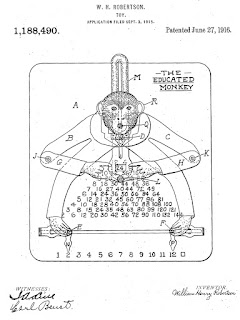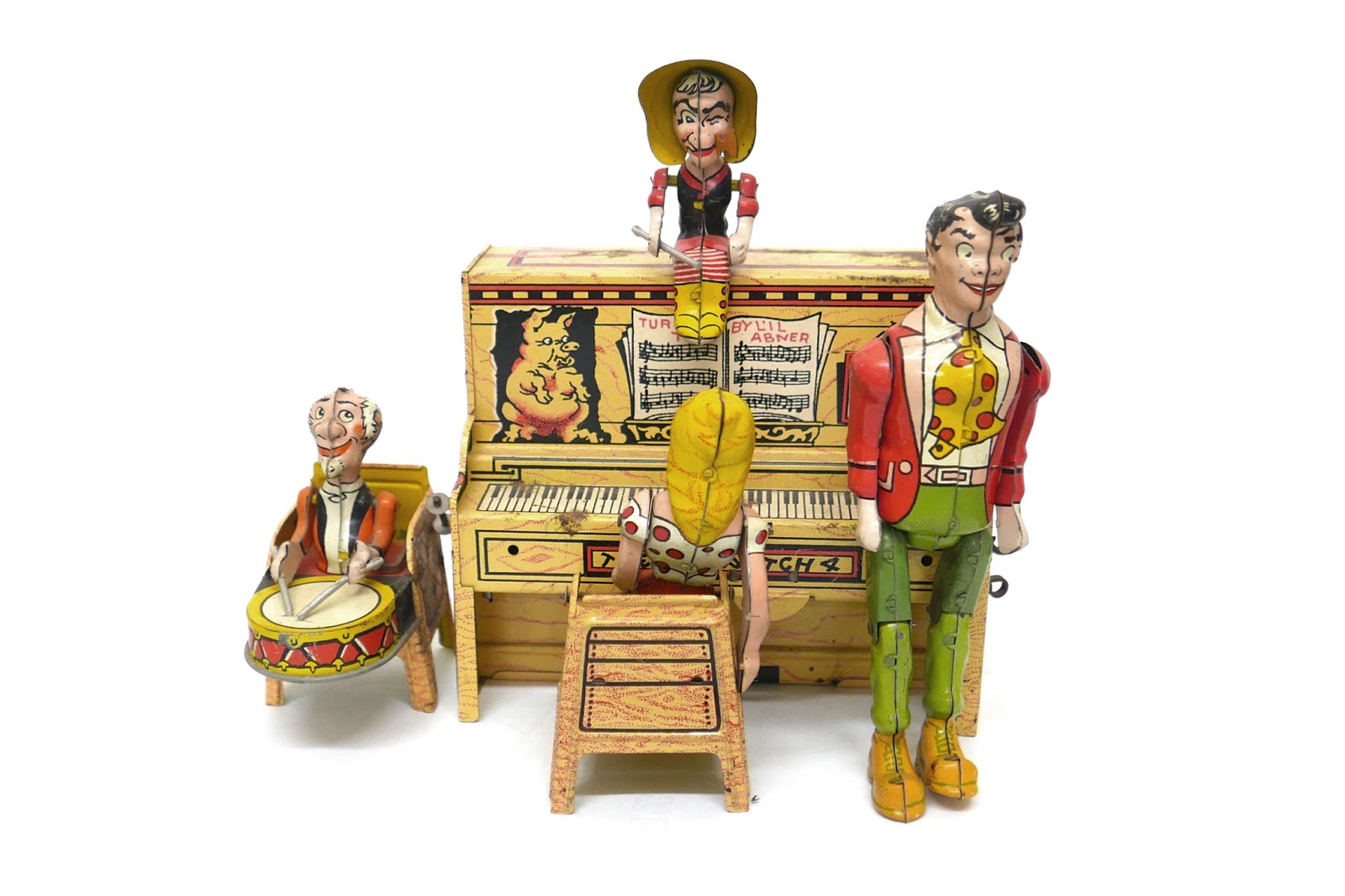 |
|
Consul the Educated Monkey, 1916-1918
William Henry Robertson (Educational Novelty Company)
Tin; 5 ½ by 6 in.
30780a
Gift of Mrs. Anita L. Alexander
|
For a Fistful of Dollars
 |
Original 1915 patent for
Consul the Educated Monkey. |
Festive and wonderful as they all are, the holidays can be a time of much consternation when it comes to gift-giving. Especially considering the vast selection now available to us, finding the perfect items for friends and family can be almost impossible. This post highlights toys from the early decades of the last century which might now be difficult to come by, but are certainly time-tested. Rather than listing prices this historic gift guide briefly examines how these objects influenced popular culture and were influenced by it themselves.
Primate Emissary of Mathematics
Though no parent ever engaged in a pugilistic bout to win their child a toy shop’s last Consul the Educated Monkey, the mathematical instrument is a marvel all the same. Consul is an easy to operate, child-friendly arithmetic calculator. Moving the chromolithographed sheet tin monkey’s legs to individual numbers on the slider causes the pivots at the arms to adjust a second slider with a box for singling out those number’s product. The toy comes with a separate insertable card for addition and notes on performing division and subtraction by reversing the process. Mathematical devices have a long history, dating at least as far back as the abacus which was invented around 1200 BC. Consul’s inventor, William Henry Robertson, noted in his 1915 patent that his design was different from all preceding mathematical instruments in that, “a number chart has never before been combined with any object resembling and representing a living creature… thereby suggesting the idea of a calculating animal. With such a' novel combination, it is intended to interest the child and increase his knowledge of numbers and number tables.” Consul the Educated Monkey’s influence in popular cultures stems from a real trained monkey: Consul the Great, who travelled to Robertson’s Dayton, Ohio workplace in 1910. The one true Consul was met with immense adoration in Europe and the United States where he emulated human behavior in gentlemanly form.
 |
|
Toy Grand Piano, 1872-1930
A. Schoenhut Co.; Philadelphia, Pennsylvania
Wood and metal; 3/16 x 15 3/4 in.
39822
Gift of Mrs. E. S. Gilbert
|
Grand, Miniature Piano
Albert Schoenhut was born in 1848 into a family of German toymakers. Deciding to break the mold, he channeled his hereditary talent into designing miniaturized playable versions of instruments. Previously, toy instruments had been made for aesthetics. Schoenhut found his passion in creating the same quality of sound as one would find in an actual piano in a toy meant for children. Rather than producing notes by key presses causing hammers to fall on strings, by opening up the hood of this toy piano we see that hammers fall on metal bars tuned to true notes. Spacing of the keys and the inclusion of multiple octaves on larger toy pianos also made a child’s performance as authentic as possible. Between the founding of Schoenhut’s own A. Schoenhut Company in Philadelphia in 1872, and the company’s dissolution in 1935, over 40 different models of toy piano were produced. The cultural result of this has been immense. Well over 100 years after Schoenhut made his first musical toy, watching Shroender’s unforgettable miniature piano performance of Jingle Bells in A Charlie Brown Christmas (1965) is still an annual ritual for many.
 |
|
Li'l Abner and his Dogpatch Band, 1945-1952
Unique Art Manufacturing Company; Newark, New Jersey
Lithographed tin; 8 x 10 in.
34120
Gift of Katherine C. Beatie
|
 |
1925 patent for Unique Art Manufacturing
Co.'s "Mechanical Toy." |
It Came from Dogpatch
As Consul indicates, pop culture has been a major source for toys long before children’s fast food meals came with figures from the latest blockbuster film. Li'l Abner (1934-1977) was an American comic strip set in Dogpatch, Kentucky which satirized Southern life—mostly in good humor. The strip found its niche in being the first American slice-of-life comic set outside of the Northeast and became wildly popular. The original 1925 patent for this complex, wind-up operated gearwork toy was held by Unique Art Manufacturing Company. Over the years the product was repainted and repackaged a number of times until 1945 when Unique purchased the rights for Li’l Abner, and created Li'l Abner and his Dogpatch Band. Instead of bland musicians playing a song not at all befitting of the complexity of the device, when Li'l Abner and his Dogpatch Band is wound up it is the leading cast of the comic performing a spastic song and dance. Therein was a world of difference. The toy became one of the most popular on the market until it and the Unique Art Manufacturing Company went out of business due to unrelated difficulties. For a time though this lively Southern-themed plaything marketed as “a unique toy for your girl or boy,” was just one of a number of interesting and unique holiday gifts given in the first half of the 20th Century.
Text and images may be under copyright. Please contact Collection Department for permission to use. Information subject to change upon further research.






Comments